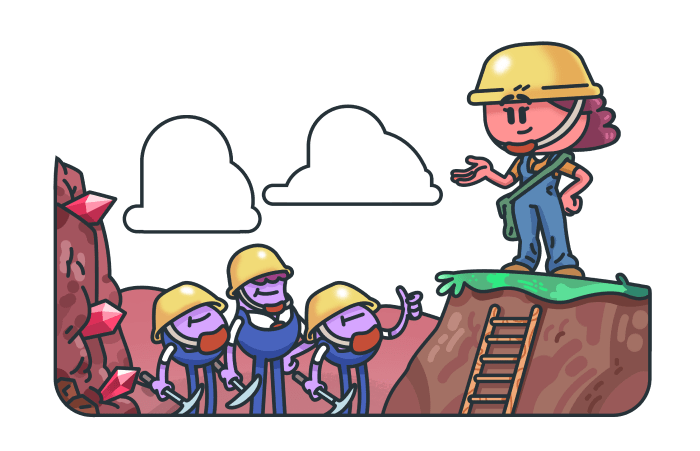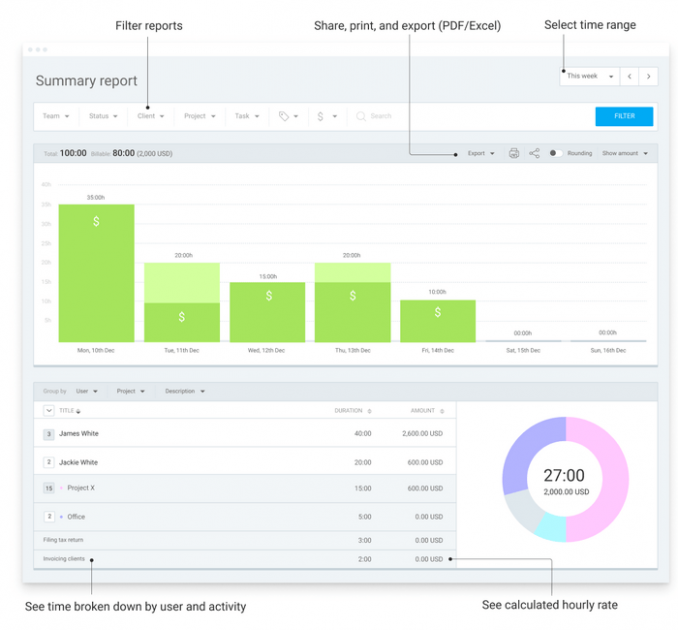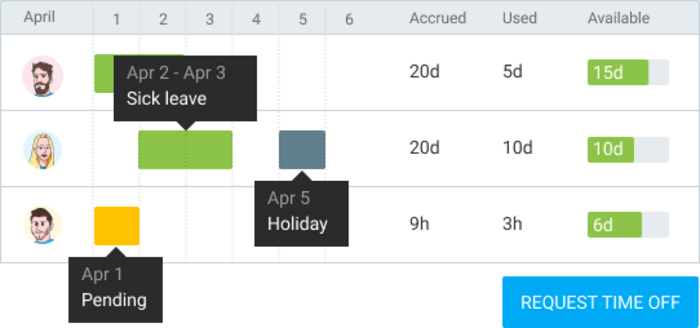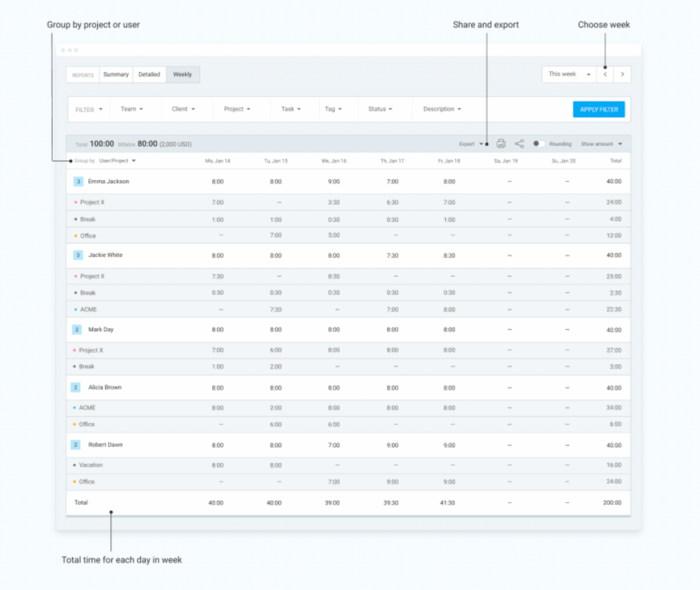What is workforce management and how it works?
Last updated on: January 6, 2022
For a while now, the term “workforce management” has been a popular one in an office setting.
But, what exactly is workforce management?
What is its importance in the workplace?
The article will provide answers to those questions, as well as guide you through the processes and steps needed to successfully implement the system.
We’ll also discuss the role of automation in workforce management and point you to the best software solutions on the market.
So, here’s everything you need to know about the topic.

Table of Contents
How does workforce management work?
According to the definition, Workforce Management (WFM) is a set of processes meant to maximize the performance levels and competency for an organization.
Workforce refers to the total number of people who are employed in a specific company, or are working on a specific task — i.e. human resources.
And, as the very definition suggests, the concept of workforce management is closely related to the optimization of workers’ productivity.
This set of processes (WFM) involves all activities meant to build and maintain a productive workforce, and further improve their efficiency and productivity levels.
There are many aspects to managing employees — and a typical WFM strategy includes the following:
- Real-time data collection — i.e. collecting workforce stats about performance management.
- Field service management (FSM) — i.e. managing the company resources currently located at the client’s property (e.g. vehicles, dispatchers, inventory…).
- Human resources management (HRM) — i.e. managing the people employed or involved in an organization or company.
- Training management (TM) — i.e. carrying out employee training within an organization or company.
- Performance management (PM) — i.e. making sure employee activities and their outputs meet the company or organization goals.
- Recruiting efforts — i.e. reaching out, shortlisting, and then selecting candidates suitable for job positions in a company or organization.
- Budgeting efforts — i.e. planning and using the company’s monetary resources for external or internal projects.
- Forecasting — i.e. predicting the future outcomes of current work.
- Scheduling — i.e. planning, controlling, and optimizing work in a company or organization.
- Carrying out the analytics — i.e. analyzing the current situation in a business or company and then providing recommendations on how to make improvements in the future.
Workforce management is a method that’s applicable to a wide range of businesses, companies, and organizations.
That being said, examples from real-life indicate that the system is still commonly tied to work in a contact/call center.
We’ll examine that purpose, as well as provide examples — just a bit later in the article.
First, let’s explain the system and the set of processes involved in workforce management, in greater detail.
What is a workforce management system?
The definition of a workforce management system is — an employee management method that helps businesses get a thorough insight into their operation and relevant business metrics.
What this means is that, in order to implement workforce management within a business, a systematic approach needs to be applied. That’s the main point of a WFM system — to streamline the processes and steps, for the highest quality implementation of workforce management.
A successful implementation of the system ensures that companies stay on track with the required processes we’ve listed above — from real-time data collection to carrying out the analytics.
Moreover, it can help leaders get a better understanding of the individual team member’s capabilities. And, by doing so, improve one of the key aspects of a thriving and profitable business — appointing the right people for each task.
To make a workforce management system as efficient as possible, you can follow a couple of carefully laid-out steps that bind some of the more crucial workforce management processes.
Before we go into detail about the specific steps, we ought to explain what is considered to be a process in this context.
What are workforce management processes?
A process, within the workforce management system, refers to an activity or a procedure that serves one of the 2 purposes — monitoring the employees’ activity and, in accordance with the data, improving the performance of the whole company.
Human resources are (arguably) the most valuable asset of a company. Therefore, a strategic business plan must ensure that the selection of your employees for each task is appropriate, as well as compatible with the selected employee’s schedule and competency level.
Now, let’s explain which processes within the WFM system exist, and further elaborate on each process.
To get optimal results, you should follow a specific order of workforce management processes. It’s because some of the processes create dependencies, meaning — their completion is required for the following process to start.
Below are the 5 vital processes that you should always include.
What you can do, however, depending on the type of your business operation, is — add other processes that you consider being relevant.
Process #1— Gather the data
Gathering the data is an obvious starting point in any kind of measurement. This is crystal clear — you can’t analyze your company’s performance, nor compare your workers’ productivity levels before obtaining the relevant data.
So, for example, you can track the time spent working to make sure you’re able to:
- make accurate forecasts for your future workload
- make new hires where necessary
- delegate and schedule tasks better
Process #2 — Forecast the workload
Once you have the relevant information about your projects and employees, you are able to make estimates. Estimates are crucial for long-term planning and accomplishing your company’s goals — on a monthly or yearly basis.
There’s another relevant aspect of making predictions about the future workload, which is — the potential need for expanding your current workforce. This will prove crucial for the following step.
So, for example, you can:
- analyze the information from your time tracking app
- use it to make predictions about the workload awaiting you in the future.
Process #3 — Calculate the staff requirements
Staff requirements refer to two relevant aspects of their performance:
- Competency
- Time spent on a task
For example, your time tracking results may show that your current staff is spending too much time on their tasks, and perhaps even missing deadlines as a result. This is a clear indication that you may need to hire more people to help up with your workload in the future, in accordance with the prediction from the previous step.
Process #4 — Build staff schedules
Properly scheduling your employees’ shifts can make or break a business, especially if your company works for 2 or more lengths of an 8-hour shift.
Depending on their energy levels and lifestyle in general, all people can be broadly categorized into — morning larks and night owls. That means there is no fixed period when everyone will feel most productive, and the fact should be reflected in the schedule.
Here are a couple of examples of how your time tracking results can help you effectively plan a schedule and assign tasks:
- If Sheila gives faster results of higher quality for a certain type of task during the morning shift, then you should primarily assign her to work in the morning. It’s because Sheila is a morning lark — her energy and productivity levels are higher in this part of the day.
- On the other hand, if Mark is shown to be the most productive worker in a night shift, then you should call him up to work this shift in urgent situations. By the analogy we’ve used, the explanation is Mark being a night owl, someone who is more productive during the night.
As we’ve mentioned earlier, it’s a broad categorization, and, it turns out, some people can fit in between — it’s a group called the intermediate type. The distribution of our energy levels throughout the day dictates our productivity levels as well.
Therefore, it’s important to pay attention to this factor when you’re creating a schedule for your employees.
Process #5 — Assess everyone’s daily performance
Higher-level employees are usually dedicated to the big picture stuff, and they can find it difficult to keep track of day-to-day activities, especially in regard to each employee. To be better informed about their workers, higher-level employees should use a workforce management system to assess employees’ performance.
For this step of assessment, it’s best to use the hours your team spends working (from the report) to answer the following questions:
- Are the selected assignees really doing that well with their assigned tasks?
- Is your staff achieving high results on a whole?
- Are the new hires really helping you achieve more?
What are the advantages of efficient workforce management?
Implementation of workforce management offers an abundance of advantages for a company and its individual employees. In gist, each of the advantages will help you deal with the important details your business needs, as workforce management:
- Makes sure you get the right people to do the right tasks, at the right time, and in the right place. As a result, you’ll likely see an increase in profits and productivity within your company or organization.
- Helps you analyze the current situation in your company. As a result, you’ll be able to maximize resources, and lower labor costs, all without lowering the quality of the work.
- Helps you stay compliant with national, local, and union laws. As a result, you’ll keep your business fully operational and legal.
- Helps people provide services with the knowledge of how they can perform their work faster. As a result, you’ll increase your customer satisfaction.
What is the importance of workforce management?
Now that you are familiar with the advantages companies gain by successfully implementing the WFM system, we can discuss the importance of workforce management, in general terms.
While many businesses still think of workforce management and planning as a simple staff requirement tool, the system is much more, as indicated by the advantages above. The set of performance-based tools and software can significantly boost said advantages, as automation by default reduces the margin of human error.
A strategic approach to maximizing your teams’ and team members’ productivity levels will result in a higher ROI, happier employees, and more satisfied clients.
To sum up, the importance revolves around the ultimate result of workforce management implementation — you’ll help your company grow in terms of productivity, therefore in profit.
On top of all that, one of the consequences is that you’ll also increase your professional reputation.
Responsibilities of a Workforce Manager
People in charge of workforce management in the workplace carry a wide array of responsibilities.
There are 7 broad categories that a Workforce Manager is usually in charge of, as listed below.
- Managing processes — i.e. establishing and carrying out the relevant goals, policies, and procedures in a company or organization.
- Managing finances — i.e. directing and overseeing all financial activities, including everything related to project budgets.
- Overseeing production — i.e. managing activities related to making products.
- Overseeing service provision — i.e. managing activities related to providing services.
- Carrying out the necessary consultations — i.e. making arrangements with teams, executives, and department heads about company operations and goals.
- Carrying out client and partnership negotiations — i.e. negotiating, but also approving all client and partner contracts.
- Handling appointing — i.e. picking and appointing department heads and team managers.
Sometimes, the owner of the company carries out most of these duties.
Other times, however, an official Workforce Manager takes on these responsibilities — on average, they earn a $75,900 salary per year.
Responsibilities of a Workforce Management Analyst
A Workforce Management Analyst carries out a more specific role in the process of workforce management. They’re usually in charge of:
- Problem-solving — i.e. gathering and organizing information around a particular problem that needs to be solved.
- Information processing — i.e. gathering and organizing information around a particular procedure or policy that needs improving.
- Personnel assessment — i.e. assessing the current personnel to determine the type of personnel that will be needed in the future.
- Equipment assessment — i.e. making onsite observations to determine the equipment that will be needed in the future.
- Finance analysis — i.e. scrutinizing expenses related to equipment and personnel in relation to the revenue, to find room for improvement.
- Finding alternatives to outdated practices — i.e. suggesting new apps, practices, and workflows the company can adopt in order to make improvements.
- Overseeing the implementation of changes — i.e. making sure the accepted changes are carried out according to plan and that they bring the promised results.
Some Workforce Management Analysts work for one specific organization or company.
However, most of them work on a contractual basis — their specific duties vary from contract to contract.
In any case, Workforce Management Analysts make a salary of $46,287 per year. The estimate is based on the average hourly rate of $16.24 you’ll need to pay for their services per hour.
What is workforce management software?
If you’re looking for an efficient way to handle your workforce management, you can try out a workforce management software. Automation is always the right choice when it comes to boosting productivity, eliminating redundancies of repetitive tasks, and lowering the margin of human error.
There are various types of workforce management software, in line with the fact that workforce management includes a large number of different activities. So let’s check out some of the relevant categories of software in order to provide an answer to the following question — do you need workforce management software?
Why should you use workforce management software?
You can benefit from using time tracking software, scheduling software, a communications platform, a human capital management system, or an HR solution for talent acquisition and employee engagement.
Regardless of the category in question, usage of software will increase your organizational performance by automating various repetitive and non-repetitive tasks. In addition, workforce management software will simplify the daily operations, all while providing you valuable analytics and insights about your current workforce.
Here’s an example of how you can use a workforce management software, such as Clockify, to manage your workforce.

This tool is meant to help you carry out workforce management processes in a quick and easy way — all based on the time everyone tracks on their tasks and projects.
You assign tasks and create related projects where your team can track their progress with said tasks.
Then, the employees track the time they spend on their assigned tasks and automatically store this data into one system.
You can then analyze this data to forecast future workload, calculate staff requirements, make decisions about staff schedules, as well as assess everyone’s daily performance.
In addition to tracking work, you can also track time off, sick leave, and vacations — all as separate projects you can then easily generate reports of.

Clockify also works great if you want to improve your workflows and scheduling by tracking attendance.
💡 Clockify pro tip:
- Want to read more about the best software on the market? Here’s a detailed list: The top 16 software for managing workforce.
An example of successful workforce management
We previously mentioned that call centers are traditionally the types of organizations that rely on workforce management.
Here’s how it looks like when a call center successfully implements the practice of workforce management — and what efficient workforce management looks like in general.
The purpose of workforce management within a call center is to:
- Ensure the right number of agents for the expected workflow
- Ensure the agents have the right set of skills to handle the expected workflow
- Make sure the agents are staffed at the right time
- Make sure the agents are staffed at the right place
Once the 4 steps have been completed, there are still some criteria that need to be met — in order to say a call center is managed successfully:
☑️ More calls made in less time
☑️ There is a decrease in the number of working hours, without negatively affecting revenue
☑️ There is a decrease in the number of working hours, without causing conflicts
☑️ There is a decrease in the number of working hours, without causing client discontent
In order to achieve this, call centers need to:
- create an efficient workflow
- be accurate with your forecasting
- methodical when assigning tasks
- systematized with your scheduling
What follows is a quick step-by-step guide to creating a successful workflow, so let’s dive in.
Steps to creating a successful workflow
The main purpose of creating a successful workflow is — to speed up the processes, originally created in call centers. So, we’ll stick with that operation in our examples below, to help you visualize what we’re talking about. There are 6 vital steps you’ll have to take if you want to optimize your workflow.
Bear in mind, a combination of these steps has to be done systematically, by each of the employees, in a way that brings no negative impact on the quality of service.
Step #1 — Figure out what you’re looking to achieve
Do you want to encourage repeat behavior? Or are you more focused on hitting certain targets? Act accordingly.
Step #2 — Record and monitor your calls
Find the calls that “work”, i.e. help you achieve your goals.
Step #3 — Hold group sessions
Have everyone listen to the successful calls.
Step #4 — Pick apart why the said calls work so well
What are the elements that helped close the deal? Write down the answers so that you’ll know what makes successful calls so effective.
Step #5 — Take notes and replicate the success
Aim to replicate the elements of the said successful calls in future calls.
Step #6 — Rinse and repeat
Reuse successful elements for every call appropriate.
Steps to successful forecasting
The main purpose of forecasting in a call center is to reach targeted service levels. Apart from that, forecasting is also used to keep staffing costs under control and within budget limits. Here are the steps to follow.
Step #1 — Analyze the current data
Figure out what are the handle times for each type of call, what is the number of successful calls, what is the number of short calls, etc.
Step #2 — Find a balance between supply and demand
Make sure your number of agents fits the number of clients that will need to be covered.
Step #3 — Strive for forecast accuracy
In order to be able to make precise estimates, make sure you’re measuring the forecast accuracy at hourly, rather than daily intervals.
Step #4 — Factor in all the unexpected factors
If we’ve learned anything from the unprecedented events of the global pandemic, it’s that we all have to be prepared to swiftly adapt as the surrounding circumstances change. We know, it’s quite an extreme parallel to make, but the point is — anything could happen, so you better be up for it.
So, for example, calls may be more frequent during popular conventions or sporting events.
Step #5 — Factor in all the possible changes
This step is again all about your ability to predict as much as you can, as well as to adapt if your prediction turns out to be incorrect.
For example, you may find an increase in volume during certain days or months or a decrease during the holidays.
Steps to successful scheduling
An efficient schedule helps you carry out a maximum of calls with minimum effort from your staff members. Now that you’ve established a successful workflow and are able to forecast the future workload, an adequate schedule is of essence.
The following steps are crucial to create a schedule that will maintain, and, if possible, further boost the success of your operation.
It seems that with the help of a quality workforce management system, you can have your cake and eat it too. What you need to do to achieve the said goal is follow these 8 steps. We’ll stick with our example of a call center, to help you visualize the whole method better, including all the steps and all the processes.
Step #1 — Be smart about scheduling
Ensure your top agents are available during peak hours.
Step #2 — Make schedules worth the effort for agents
Provide extra incentives to top agents to always work during peak hours.
Step #3 — Factor in non-work activities
Adjust the time or breaks, lunches, meetings, and actual calls in accordance with each other.
Step #4 — Take advantage of the extra time
Provide agents with other secondary work when they’re not working on calls.
Step #5 — Be flexible
Provide agents with the option to choose to work a condensed work week if they need to.
Step #6 — Be prepared
Keep back-up agents for an unexpected situation when the scheduled agent cannot work the expected shift.
Step #7 — Have the staff match the workload
If necessary based on demand levels, hire more agents. But, bear in mind that overworking can have a seriously damaging effect on both the physical and mental health of your employees, so try to recognize whether they’re being overworked to prevent more damaging consequences.
Step #8 — Be methodical and fast when addressing problems
Monitor the calendar and aim to address issues as soon as possible.
Steps to successful assigning
The next set of steps is tied to your schedule. Once the right people are in the shift they feel most productive, there’s still one more choice to make.
It’s because different employees’ strategies vary — from basic things such as their tone, level of formality, etc. Matching the right agent with the right client will greatly improve customer satisfaction, and you can use the following steps to maximize the satisfaction rates.
Step #1 — Assign calls according to the department
— i.e. depending on whether the agents working in sales, marketing, or support can best answer.
Step #2 — Assign calls according to the skill sets
— i.e. depending on the agent’s area of expertise and the tasks they’ve proven the most skilled during training sessions.

Here’s an example of how the Clockify report looks like. You can instantly compare the team members’ performance in a selected period of time, or while working on a specific project. That way, it’s much easier to determine who will be your choice for the next task.
Moreover, managers who monitor the skills and competencies of their employees are more likely to appoint the most skilled ones to the most important tasks.
Step #3 — Assign calls according to knowledge
— i.e. depending on the agent’s proficiency with a type of software or knowledge about a particular product feature.
Step #4 — Assign calls according to language
— i.e. depending on the agent’s proficiency in the language spoken by the client.
Step #5 — Assign calls according to demographics
— i.e. depending on the agent’s understanding of the needs of a particular age group.
Step #6 — Assign calls according to a geographic location
— i.e. depending on the agent’s understanding of the needs of a particular nation.
In conclusion…
Workforce management is a set of processes focused on helping you maximize the performance of your employees in order to reach your company’s predefined goals.
It’s a wide-reaching system that cautions you to keep an eye on all important details in your business.
As such, it should be a staple in any company or organization looking to streamline work processes, increase productivity, stay compliant, as well as have satisfied customers and clients.
✉️ Does your company leverage the power of workforce management? Are there any important benefits that we haven’t included in the article? Let us know by writing to blogfeedback@clockify.me and we will consider adding your suggestions in our next update of this topic.





